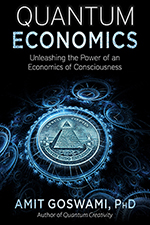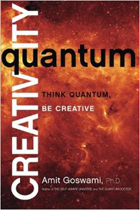Those damnable Fossil gaps! Why should we care?
By Amit Goswami, Ph.D.
Everybody is by now familiar with the fossil gaps. Contrary to a great number of biologists’ expectations starting with Darwin, the fossil gaps have never filled up with the thousands upon thousands of predicted intermediates. The vast majority of the gaps are real; about this there is no doubt. So what do they signify? What do they prove.
Neo-Darwinists, and the majority of biologists, fall into a dogmatic worldview insisting that the fossil gaps mean nothing. They are sold on a promissory evolutionism—faithfully believing that eventually the gaps will fill up.
The most vocal public opponents of this view are followers of Biblical creationism, the idea that God created life, literally, all at once. In this view there is no evolution. Fossils mean nothing significant and the fossil gaps are the living (or should one say dead) proof of this.
According to creationism, there cannot be any intermediates whatsoever. So today, biologists tout the few intermediates that are found in the fossil data as evidence for their faith in evolution as well as for their devotion to Darwinism. This is highly misleading.
It is true that the existence of intermediates between two fossil lineages (as between reptiles and birds) refutes creationism and proves evolutionism, but evolutionism is not synonymous with Darwinism that would require thousands upon thousands of such intermediates to verify.
A slightly less radical view held by neither of these two groups subscribes to a philosophy called intelligent design. Like creationists, they (most of them anyway), too, believe (unnecessarily) that the fossil gaps equate to the absence of evolution. They believe species do not change much and an intelligent designer created them all apparently all at once. Implicitly, the intelligent designer is assumed to be God, even though no reference is made to the Bible.
It is easy to criticize the creationists and the intelligent design theorists. The Biblical account of the creation of the world and the life in it, if taken literally, is just plain wrong; the geological and radioactive data evidence is against it. The intelligent design proponents are also wrong in part—there is too much evidence that species evolve from older species, we have too much in common with monkeys, monkeys have too much in common with lower (in the evolutionary ladder) mammals, and so forth. Even today, if you look at early development of the embryo of a “higher” species, you will find that the stages resemble lower creatures of the earlier era. The Darwinists got this one right! Later species evolve from earlier ancestors; there is no doubt about it.
Still neo-Darwinists are dead wrong when they say there is no meaning or purpose to evolution emphatically denying any play of intelligence in the design of life. Their insistence that evolution is a material process of blind chance and survival necessity is myopic. Neo-Darwinists are materialists, the ax they grind is the idea that everything is made of matter via upward causation and all life is the play of DNA that carry hereditary information. There is no scope in such a philosophy to talk about meaning, or purpose, or intelligent design except for any survival value that these ideas may have.
For meaning to evolve as an adaptive survival value, matter must be able to process meaning. But in grammar, there is a categorical difference between syntax and meaning. The symbol processing by matter in the form of a computer is akin to processing syntax; so the idea of meaning processing by matter has always been a little suspect (Searle, 1980, 1994). And recent research (Penrose, 1990) has confirmed that computers can never process meaning. How can nature select a quality from matter that matter cannot process?
This failure to explain intelligent qualities as evolutionary adaptation becomes even more obvious when we ask, how does our ability to discover a scientific law arise? While such a discovery does have survival value the question becomes, how can the knowledge of scientific laws be coded into matter? Attempts to prove that such is the case have not had any success whatsoever.
The question of how consciousness can evolve in matter is another case in point. Can matter codify consciousness? If material interactions can never produce consciousness, to think of consciousness as an adaptive evolved value does not make any sense. How can interacting objects ever produce a subject-object split awareness? The conclusive scientific proof that there is purpose in God’s creation is that there is a biological arrow of time. By looking at the fossil data you can discern the direction and trajectory of this biological arrow. The movement is one that travels from the past, where data shows relatively simple life forms, to later manifestations when the fossil data shows a greater and greater complexity of life forms. Humans are the most recent and the most complex of living creatures. So the purpose of evolution and time’s arrow moves from simplicity to complexity of living organisms.
Creative evolution has a built-in propensity for producing new organs of complexity. So creative evolution solves the problem of the biological arrow of time: evolution proceeds in the direction of making more and more sophisticated expressions represented as more and more biological functions.
So, what is the fossil gaps evidence for? Apart from the slow tempo of evolution that Darwin suggested and upon which neo-Darwinists are sold, there is a fast tempo of evolution—so fast that there isn’t time for the formation of fossils. This fast tempo is what produces the fossil gaps. In other words, evolution is like punctuated prose; there are abrupt and discontinuous punctuation marks among the otherwise continuous prose (Eldredge and Gould, 1972).
Another class of biologists called developmental biologists have de facto supported this idea of a second tempo. For they believe that significant evolution at the macro level must involve the coming into being of a novel organ. But a complex organ cannot evolve piece by piece. A little piece of an eye is no good for seeing. So such “macro-evolution” must be discontinuous requiring a fast tempo. But because in biology there has never been any plausible suggestion of a mechanism for a fast tempo, the idea has not found general acceptance in the biological community.
There are, however, biologists who point out another important piece of data that also suggests discontinuity. Before all great creative evolutionary epochs of macroevolution, there always occurs some kind of catastrophe leading to a massive extinction of biological species (Ager, 1981). These catastrophes clear up the biological landscape permitting the new evolution of species, who are now free from the need to compete for survival, thus throwing a wrench into the Darwinian view.
Fossil data is some of the best proof of the existence of God and of God’s creativity. Creativity occurs through quantum leaps, taking no time. This I submit as the new mechanism revealing the fast tempo of evolution! This theory integrates the thinking of everyone: from intelligent design theorists to developmental biologists, the catastrophe thinkers and even the open-minded Darwinist.
The biggest problem of biological macroevolution is that macroevolution requires so many changes at the genetic level. For example the development of an eye from scratch requires literally thousand and thousands of new genes. But each gene mutation or variation, according to neo-Darwinism, is selected upon individually. The likelihood of its being individually beneficial is quite small; in fact, gene variations are often downright harmful to the survival of the organism. So chances are high that individual selection would eliminate most gene variations. Considering this, it is easy to see that it must take a very long time, much longer than the geological time scale over which evolution occurs, to accumulate so many beneficial gene variations necessary for macroevolution.
This situation is solved by the idea of unconscious processing, for it is conscious processing which costs too much time, guided by the slow plodding of trial and error; but in quantum thinking, the gene variations are quantum possibilities (Elssasser, 1981). Biologists doing classical thinking assume that the quantum gene variations would collapse without any help from consciousness; but we know better; quantum collapse requires consciousness and its power of downward causation. Consciousness does not collapse the unexpressed genetic variations until a whole configuration that when expressed will make a new organ. Consciousness waits for the right moment, as we do in our own creative process.
What is crucial is that consciousness has the vital blueprint of the organ unconsciously giving it a rough guideline of what to process for. When there is a match, a quantum leap takes place all at once and consciousness makes a physical (organ) representation of the morphogenetic blueprint expressing all the necessary uncollapsed genes all at once (Goswami, 1997a, 1997b). No fossil record for the intermediate stages, because there are no intermediate stages!
In this way you see clearly that the fossil gaps are evidence of biological creativity, they are evidence of quantum leaps in evolution. And as such they provide us with one of the most spectacular bits of evidence for God (as quantum consciousness) and of God’s creativity.



